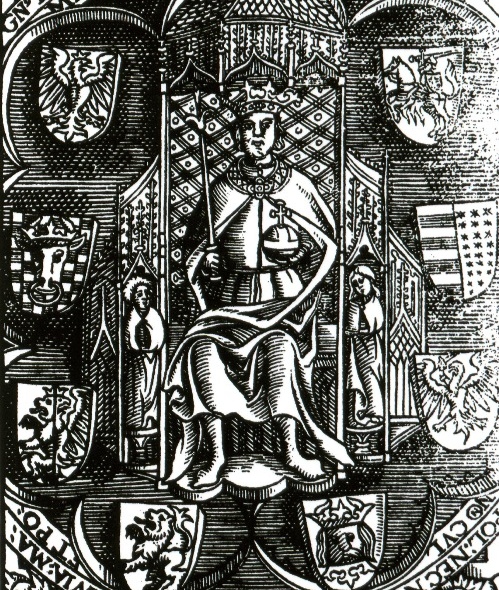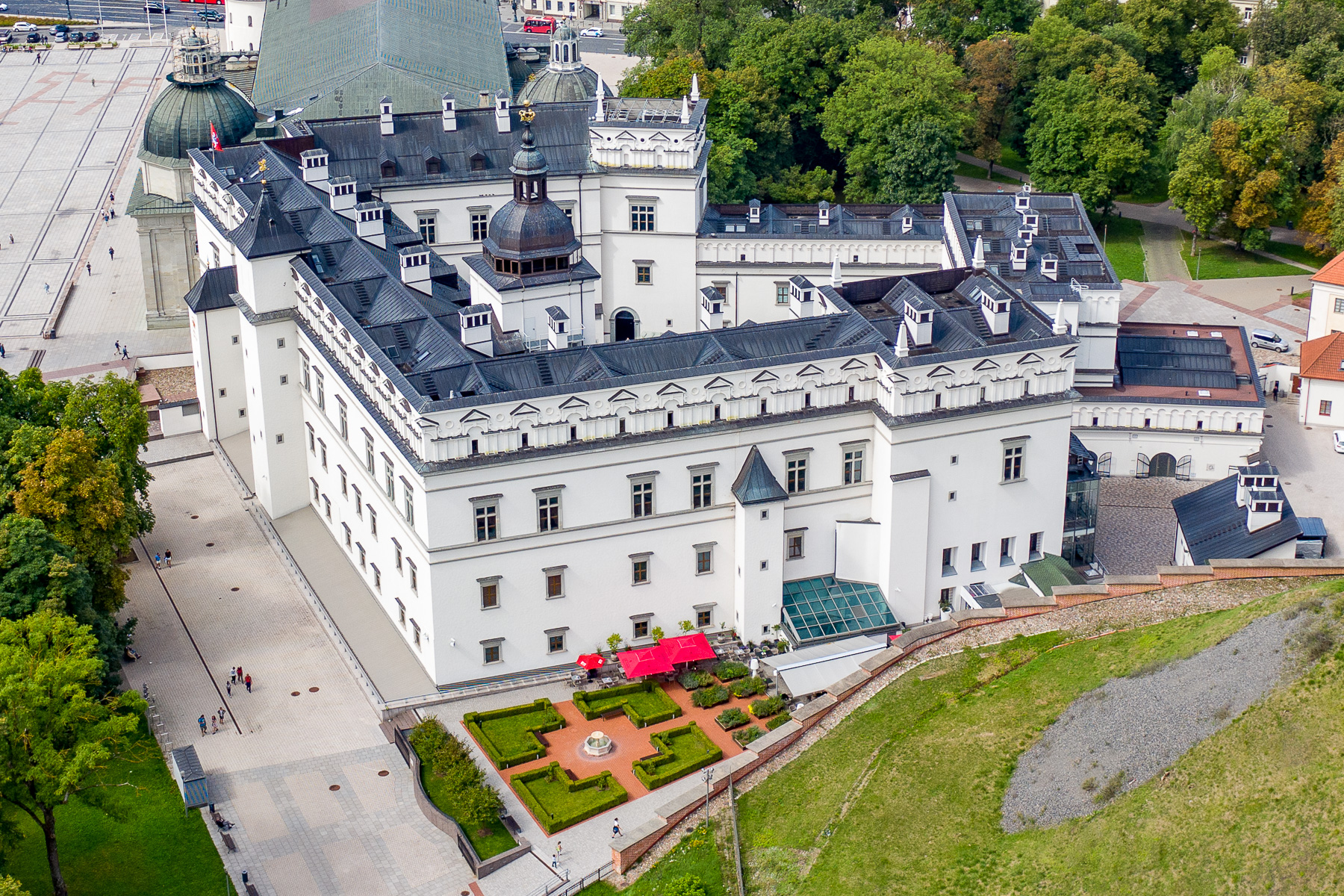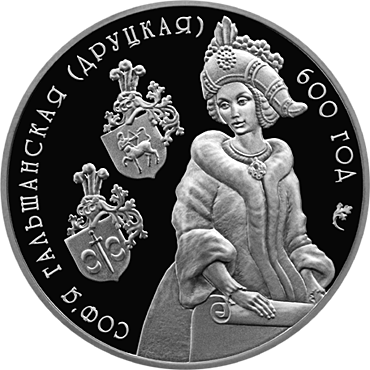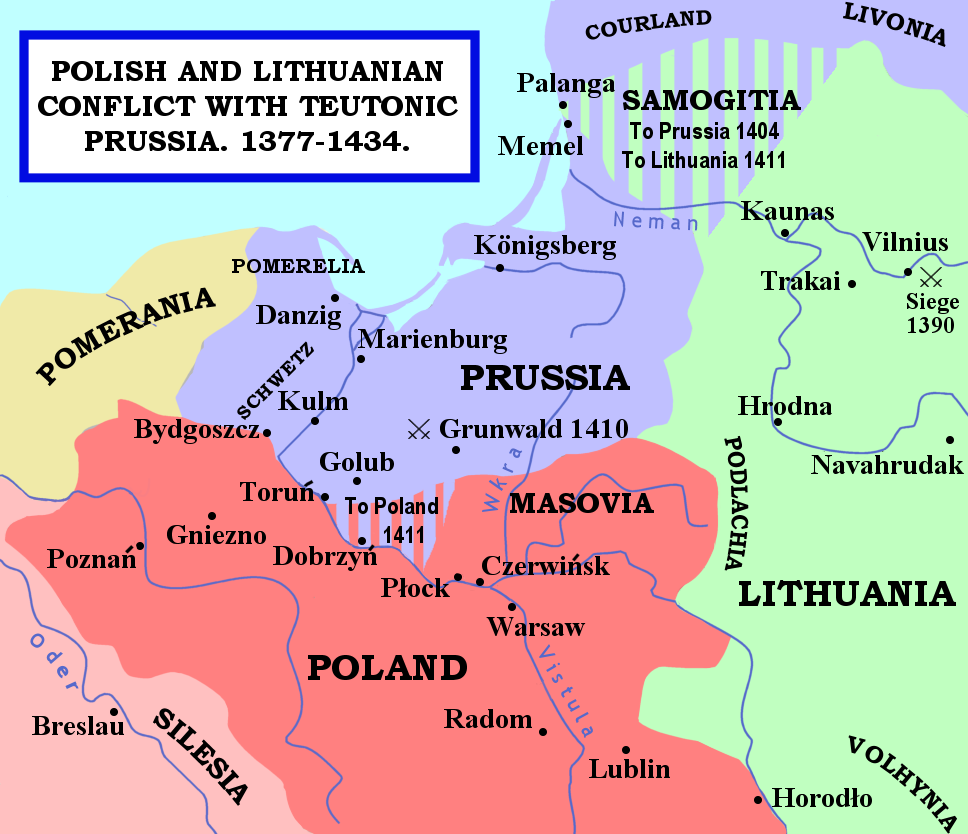|
Kazimierz Jagiellonczyk
Casimir IV (Casimir Andrew Jagiellon; ; Lithuanian: ; 30 November 1427 – 7 June 1492) was Grand Duke of Lithuania from 1440 and King of Poland from 1447 until his death in 1492. He was one of the most active Polish-Lithuanian rulers; under him, Poland defeated the Teutonic Knights in the Thirteen Years' War and recovered Pomerania. The Jagiellonian dynasty became one of the leading royal houses in Europe. The great triumph of his reign was bringing Prussia under Polish rule. The rule of Casimir corresponded to the age of "new monarchies" in western Europe. By the 15th century, Poland had narrowed the distance separating it from Western Europe and became a significant power in international relations. The demand for raw materials and semi-finished goods stimulated trade, producing a positive balance, and contributed to the growth of crafts and mining in the entire country. He was a recipient of the English Order of the Garter (KG), the highest order of chivalry and the most ... [...More Info...] [...Related Items...] OR: [Wikipedia] [Google] [Baidu] |
Grand Duke Of Lithuania
This is a list of Lithuanian monarchs who ruled Lithuania from its inception until the fall of the Grand Duchy of Lithuania in 1795. The Lithuanian monarch bore the title of Grand duke, Grand Duke, with the exception of Mindaugas, who was crowned king in 1253. Other Lithuanian rulers, such as Vytautas the Great, also attempted to secure a royal coronation, but these efforts were unsuccessful.Nadveckė, Ineta (6 July 2019Trys Lietuvos karaliai: vienas tikras, vienas nelabai ir vienas beveik''Lithuanian National Radio and Television, LRT''. Until 1569, the Lithuanian monarchy was hereditary. In 1386, Grand Duke Jogaila was elected King of Poland. From that point onward, with some interruptions, the two states were united in a personal union, sharing a common ruler until 1569, when they were formally merged by the Union of Lublin to form the Polish–Lithuanian Commonwealth. The monarch of this new state was elected in a free election by the entire nobility. From the Christianizat ... [...More Info...] [...Related Items...] OR: [Wikipedia] [Google] [Baidu] |
Barbara Jagiellon
Barbara Jagiellon (, ; 15 July 1478 – 15 February 1534) was a princess of the Kingdom of Poland and of the Grand Duchy of Lithuania, member of the Jagiellonian dynasty and by marriage Duchess of Saxony. Born in Sandomierz, she was the sixth daughter of King Casimir IV of Poland and Archduchess Elisabeth of Austria. She was named after her great-grandmother, Barbara of Cilli, Holy Roman Empress. Life Barbara was married on 21 November 1496 in a glittering ceremony in Leipzig to George, Duke of Saxony (1471–1539). At the wedding, 6,286 German and Polish nobles were said to be present. This marriage was a key part of maintaining good diplomatic relations between Germany and Poland. For Barbara's family, the marriage was also important due to their rivalry with the House of Habsburg. In 1513, Barbara and her husband founded Meissen Cathedral; several Masses and liturgical celebration of Easter have been recorded to have taken place since then. Barbara sent letters to he ... [...More Info...] [...Related Items...] OR: [Wikipedia] [Google] [Baidu] |
Western Europe
Western Europe is the western region of Europe. The region's extent varies depending on context. The concept of "the West" appeared in Europe in juxtaposition to "the East" and originally applied to the Western half of the ancient Mediterranean world, the Latin West of the Roman Empire, and "Western Christendom". Beginning with the Renaissance and the Age of Discovery, roughly from the 15th century, the concept of ''Europe'' as "the Western world, West" slowly became distinguished from and eventually replaced the dominant use of "Christendom" as the preferred endonym within the area. By the Age of Enlightenment and the Industrial Revolution, the concepts of "Eastern Europe" and "Western Europe" were more regularly used. The distinctiveness of Western Europe became most apparent during the Cold War, when Europe was divided for 40 years by the Iron Curtain into the Western Bloc and Eastern Bloc, each characterised by distinct political and economical systems. Historical divisions ... [...More Info...] [...Related Items...] OR: [Wikipedia] [Google] [Baidu] |
Prussia
Prussia (; ; Old Prussian: ''Prūsija'') was a Germans, German state centred on the North European Plain that originated from the 1525 secularization of the Prussia (region), Prussian part of the State of the Teutonic Order. For centuries, the House of Hohenzollern ruled Prussia, expanding its size with the Prussian Army. Prussia, with its capital at Königsberg and then, when it became the Kingdom of Prussia in 1701, History of Berlin, Berlin, decisively shaped the history of Germany. Prussia formed the German Empire when it united the German states in 1871. It was ''de facto'' dissolved by 1932 Prussian coup d'état, an emergency decree transferring powers of the Prussian government to German Chancellor Franz von Papen in 1932 and ''de jure'' by Abolition of Prussia, an Allied decree in 1947. The name ''Prussia'' derives from the Old Prussians who were conquered by the Teutonic Knightsan organized Catholic medieval Military order (religious society), military order of Pru ... [...More Info...] [...Related Items...] OR: [Wikipedia] [Google] [Baidu] |
Jagiellonian Dynasty
The Jagiellonian ( ) or Jagellonian dynasty ( ; ; ), otherwise the Jagiellon dynasty (), the House of Jagiellon (), or simply the Jagiellons (; ; ), was the name assumed by a cadet branch of the Lithuanian ducal dynasty of Gediminids upon reception by Jogaila, the Grand Duke of Lithuania, of baptism as Ladislaus in 1386, which paved the way to his ensuing marriage to the Queen Regnant Hedwig of Poland, resulting in his ascension to the Crown of the Kingdom of Poland as Ladislaus II Jagiełło (initially ruling ''jure uxoris'' jointly with Jadwiga until her death), and the effective promotion of his branch to a royal dynasty. The Jagiellons were polyglots and per historical evidence Casimir IV Jagiellon and his son Saint Casimir possibly were the last Jagiellons who spoke in their patrilineality, patrilineal ancestors' Lithuanian language; however, even the last patrilineal Jagiellonian monarch Sigismund II Augustus maintained two separate and equally lavish Lithuanian-speaking an ... [...More Info...] [...Related Items...] OR: [Wikipedia] [Google] [Baidu] |
Pomerania
Pomerania ( ; ; ; ) is a historical region on the southern shore of the Baltic Sea in Central Europe, split between Poland and Germany. The central and eastern part belongs to the West Pomeranian Voivodeship, West Pomeranian, Pomeranian Voivodeship, Pomeranian and Kuyavian-Pomeranian Voivodeship, Kuyavian-Pomeranian voivodeships of Poland, while the western part belongs to the German states of Mecklenburg-Western Pomerania and Brandenburg. Pomerania's historical border in the west is the Mecklenburg-Western Pomeranian border ''Urstromtal'', which now constitutes the border between the Mecklenburgian and Pomeranian part of Mecklenburg-Western Pomerania, while it is bounded by the Vistula River in the east. The easternmost part of Pomerania is alternatively known as Pomerelia, consisting of four sub-regions: Kashubia inhabited by ethnic Kashubians, Kociewie, Tuchola Forest and Chełmno Land. Pomerania has a relatively low population density, with its largest cities being Gdańsk ... [...More Info...] [...Related Items...] OR: [Wikipedia] [Google] [Baidu] |
Thirteen Years' War (1454–66)
Thirteen Years' War may refer to: *the Thirteen Years' War (1454–1466) between the Prussian Confederation and Poland versus the Teutonic Order state *the Long Turkish War (1593–1606) between the Habsburg Monarchy and the Ottoman Empire *the Russo-Polish War (1654–1667) Armed conflicts between Poland (including the Polish–Lithuanian Commonwealth and the Crown of the Kingdom of Poland) and Russia (including the Soviet Union, the Russian Empire, the Tsardom of Russia and the Principality of Moscow) include: : : ... between Russia, the Cossacks and the Polish–Lithuanian Commonwealth See also * Fifteen Years War (other) {{dab ... [...More Info...] [...Related Items...] OR: [Wikipedia] [Google] [Baidu] |
Teutonic Knights
The Teutonic Order is a Catholic religious institution founded as a military society in Acre, Kingdom of Jerusalem. The Order of Brothers of the German House of Saint Mary in Jerusalem was formed to aid Christians on their pilgrimages to the Holy Land and to establish hospitals. Its members have commonly been known as the Teutonic Knights, having historically served as a crusading military order for supporting Catholic rule in the Holy Land and the Northern Crusades during the Middle Ages, as well as supplying military protection for Catholics in Eastern Europe. Purely religious since 1810, the Teutonic Order still confers limited honorary knighthoods. The Bailiwick of Utrecht of the Teutonic Order, a Protestant chivalric order, is descended from the same medieval military order and also continues to award knighthoods and perform charitable work. Name The name of the Order of Brothers of the German House of Saint Mary in Jerusalem is in and in Latin . Thus the term "T ... [...More Info...] [...Related Items...] OR: [Wikipedia] [Google] [Baidu] |
Lithuanian Language
Lithuanian (, ) is an East Baltic languages, East Baltic language belonging to the Baltic languages, Baltic branch of the Indo-European language family. It is the language of Lithuanians and the official language of Lithuania as well as one of the official languages of the European Union. There are approximately 2.8 million native Lithuanian speakers in Lithuania and about 1 million speakers elsewhere. Around half a million inhabitants of Lithuania of non-Lithuanian background speak Lithuanian daily as a second language. Lithuanian is closely related to neighbouring Latvian language, Latvian, though the two languages are not mutually intelligible. It is written in a Latin script. In some respects, some linguists consider it to be the most conservative (language), conservative of the existing Indo-European languages, retaining features of the Proto-Indo-European language that had disappeared through development from other descendant languages. History Among Indo-European languag ... [...More Info...] [...Related Items...] OR: [Wikipedia] [Google] [Baidu] |
Sophia Of Halshany
Sophia of Halshany (; ; ; – 21 September 1461 in Kraków), known simply as Sonka, was a princess of Lithuanian Alšėniškiai princely family who was Queen of Poland as the fourth and last wife of Jogaila, King of Poland and Supreme Duke of Lithuania. As the mother to Władysław III and Casimir IV, she was the co-founder of the Jagiellonian dynasty. Early life and marriage to Jogaila Sophia was the niece of Uliana Olshanska, the wife of Vytautas, and a middle daughter of , son of Vytautas' right-hand man Ivan Olshansky, and , daughter of Dmitry of Druck. Historians disagree on the identity of Dmitry: Polish historiography usually provides Jogaila's half-brother Dmitry I Starshiy while Russian historians provide Dimitri Semenovich of Rurikid origin. Her father died when she was young and the family moved to Druck to live with Alexandra's brother Siemion Drucki. Sophia grew up in a Ruthenian environment and was an Eastern Orthodox Christian (her Orthodox name is Sop ... [...More Info...] [...Related Items...] OR: [Wikipedia] [Google] [Baidu] |
Władysław II Jagiełło
Jogaila (; 1 June 1434), later Władysław II Jagiełło (),Other names include (; ) (see also Names and titles of Władysław II Jagiełło) was Grand Duke of Lithuania beginning in 1377 and starting in 1386, becoming King of Poland as well. As Grand Duke, he ruled Lithuania from 1377 to 1381 and from 1382 to 1401, at which time he became the Supreme Duke of Lithuania in exchange for naming his cousin Vytautas as the new Grand Duke. Władysław II initially served as King of Poland alongside his wife Jadwiga of Poland, Jadwiga until her death in 1399, and then the sole ruler until his own death in 1434. Raised a Lithuanian polytheist, he converted to Catholicism in 1386 and baptized as Ladislaus () in Kraków, married the young Queen Jadwiga, and was crowned King of Poland as Władysław II Jagiełło. In 1387, he Christianization of Lithuania, converted Lithuania to Catholicism. His reign in Poland started in 1399, upon the death of Queen Jadwiga, lasted a further thirty-fiv ... [...More Info...] [...Related Items...] OR: [Wikipedia] [Google] [Baidu] |
Old Grodno Castle
The Old Grodno Castle (; also known as the ''Grodno Upper Castle'' and ''Bathory's Castle'') in Grodno, Belarus, originated in the 11th century as the seat of a dynasty of Black Ruthenian rulers, descended from a younger son of Yaroslav the Wise of Kiev. History Construction The first wooden castle was built in the 11th century at the confluence of the Neman and the Gorodnichanka rivers. The 13th-century keep of the castle belonged to a type of Belarusian defensive tower represented by the Tower of Kamyanyets. Vytautas the Great rebuilt the castle in stone and added five Brick Gothic towers in 1391–98, transforming it into one of his main residences. Casimir IV Jagiellon also favoured Grodno over Lithuania's official capital. It was there that the Polish Crown was offered to him, and it was there that he died in 1492. The next notable tenant of the castle was Stephen Báthory who envisaged Grodno as the capital of his vast empire in Eastern Europe. He engaged Scotto o ... [...More Info...] [...Related Items...] OR: [Wikipedia] [Google] [Baidu] |






